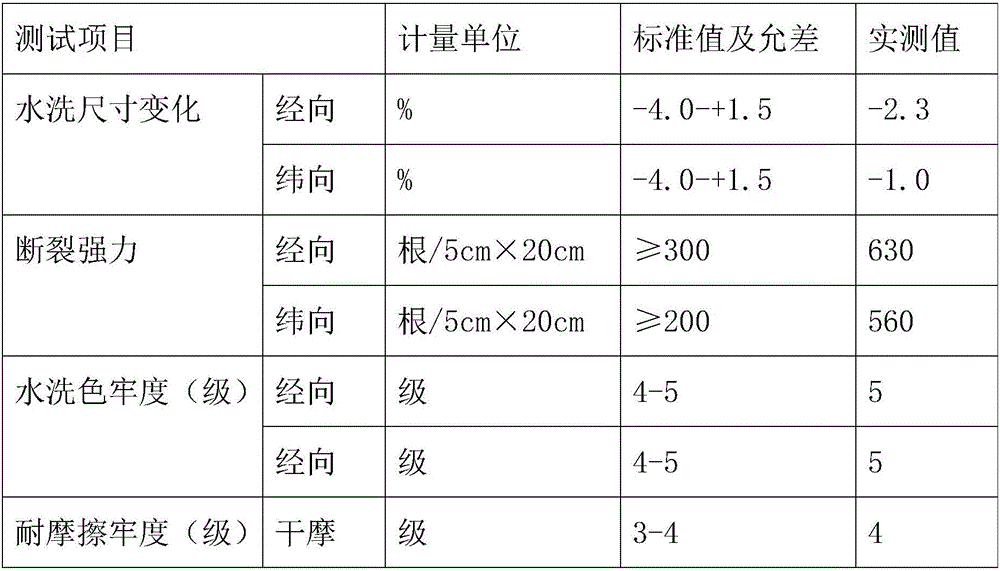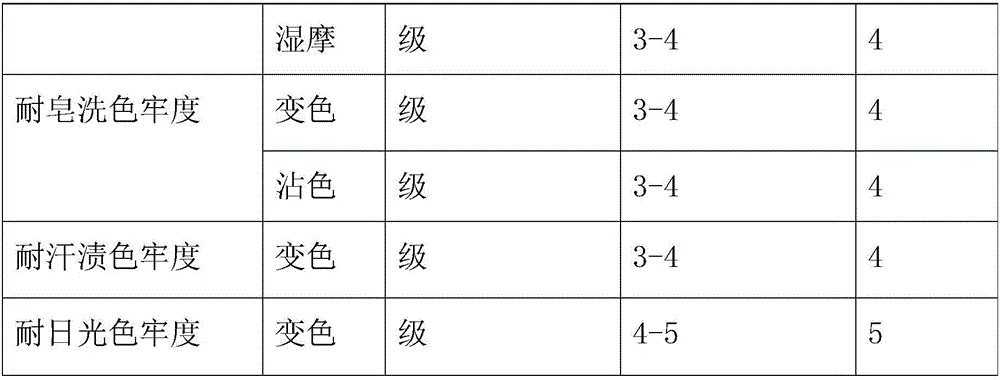Reduced dye dyeing and finishing process for ramie fabric
A fabric and ramie technology, applied in the field of vat dye dyeing and finishing process, can solve problems such as rough hand feel, difficult handling, itch and shrinkage rate, etc., to improve strength and appearance flatness, improve the ability to absorb dyes, and increase size The effect of stability
- Summary
- Abstract
- Description
- Claims
- Application Information
AI Technical Summary
Problems solved by technology
Method used
Image
Examples
Embodiment 1
[0022] A vat dyeing and finishing process for ramie fabrics, comprising the steps:
[0023] S1, pre-treatment, padding the ramie fabric at 60°C with a working solution, the bath ratio is 1:35, two dipping and two rolling, the excess rate is 90%, the working solution includes: scouring agent 3g / L, hydrogen peroxide 5g / L, desizing enzyme 6g / L, cellulase 0.5g / L, penetrant 3g / L, urea 1g / L, steam at 105°C for 20min, hot wash at 95°C, cold wash, dry, Carry out pre-setting again, add 8g / L of heat-resistant yellowing agent, the pre-setting temperature is 165°C, and the vehicle speed is 15m / min;
[0024] S2, finishing and modification, the ramie fabric after the pretreatment of S1 is dipped and rolled in the finishing solution at 45°C, the bath ratio is 1:30, two dipping and two rolling, the finishing solution includes: β-cyclodextrin 5g / L , polycarboxylic acid 15g / L, sodium hypophosphite 0.5g / L, pre-bake at 100°C for 2min, then bake at 140°C for 1min, wash with water at 85°C and dry...
Embodiment 2
[0028] A vat dyeing and finishing process for ramie fabrics, comprising the steps:
[0029] S1, pre-treatment, padding the ramie fabric at 70°C with a working solution, the bath ratio is 1:25, two dipping and two rolling, the excess rate is 110%, and the working solution includes: scouring agent 1g / L, hydrogen peroxide 8g / L, desizing enzyme BF-76584g / L, cellulase 1g / L, penetrant 1g / L, urea 3g / L, steam at 100°C for 30min, hot wash at 90°C, cold wash, dry , and then carry out pre-setting, add 10g / L heat-resistant yellowing agent, the pre-setting temperature is 155°C, and the vehicle speed is 25m / min;
[0030] S2, finishing and modification, padding the ramie fabric after the pretreatment of S1 at 55°C with a bath ratio of 1:20, two dipping and two rolling, the finishing solution includes: β-cyclodextrin 10g / L , polycarboxylic acid 5g / L, sodium hypophosphite 2g / L, triethanolamine 0.5g / L, sodium chloride 5g / L, pre-bake at 90°C for 4min, then bake at 120°C for 5min, wash with wat...
Embodiment 3
[0034] A vat dyeing and finishing process for ramie fabrics, comprising the steps:
[0035] S1, pre-treatment, padding the ramie fabric at 65°C with a working solution, the bath ratio is 1:30, two dipping and two rolling, the excess rate is 100%, the working solution includes: scouring agent 2g / L, hydrogen peroxide 6g / L, desizing enzyme BF-76585g / L, cellulase 0.7g / L, penetrant 2g / L, urea 2g / L, steam at 102°C for 25min, hot wash at 92°C, cold wash, dry Dry, then carry out pre-setting, add 9g / L heat-resistant yellowing agent, pre-setting temperature is 160°C, and the speed is 20m / min;
[0036] S2, finishing and modification, the ramie fabric after the pretreatment of S1 is dipped and rolled in the finishing solution at 50°C, the bath ratio is 1:25, two dipping and two rolling, the finishing solution includes: β-cyclodextrin 7g / L , polycarboxylic acid 10g / L, sodium hypophosphite 1g / L, triethanolamine 0.7g / L, sodium chloride 3g / L, pre-bake at 95°C for 3min, then bake at 130°C fo...
PUM
 Login to View More
Login to View More Abstract
Description
Claims
Application Information
 Login to View More
Login to View More - R&D
- Intellectual Property
- Life Sciences
- Materials
- Tech Scout
- Unparalleled Data Quality
- Higher Quality Content
- 60% Fewer Hallucinations
Browse by: Latest US Patents, China's latest patents, Technical Efficacy Thesaurus, Application Domain, Technology Topic, Popular Technical Reports.
© 2025 PatSnap. All rights reserved.Legal|Privacy policy|Modern Slavery Act Transparency Statement|Sitemap|About US| Contact US: help@patsnap.com


